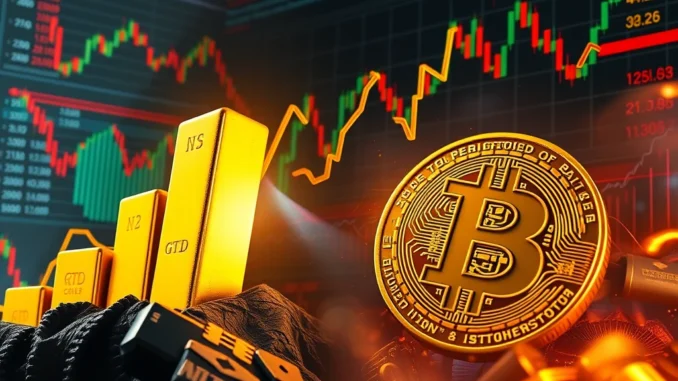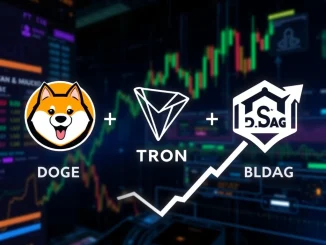
Hold onto your hats, crypto enthusiasts! The investment landscape is witnessing a dramatic shift that’s got everyone talking. While Bitcoin has long been touted as ‘digital gold,’ recent market movements are painting a different picture, at least in the short term. Buckle up as we dive into the fascinating world of ETF flows and uncover why gold is gleaming brighter than Bitcoin right now.
Why Are Gold ETFs Attracting Billions While Bitcoin ETFs Bleed?
Let’s get straight to the point: numbers don’t lie. Over the past month, Gold ETFs have experienced a staggering $10 billion influx of capital, according to CoinDesk. On the flip side, Bitcoin ETFs have seen a concerning $5 billion outflow. This is a stark contrast, especially considering the hype and excitement surrounding Bitcoin ETFs earlier this year. What’s behind this surprising divergence?
Decoding the ETF Flow Dynamics: Gold vs. Bitcoin
To understand this investment shift, we need to delve into the factors currently influencing investor sentiment. Several key elements are at play, driving investors towards the traditional safe haven of gold and away from the more volatile Bitcoin. Let’s break them down:
- Inflation Fears: Inflation remains a persistent concern globally. As the purchasing power of fiat currencies erodes, investors often flock to assets perceived as inflation hedges. Gold has historically been considered a reliable store of value during inflationary periods, and this sentiment is clearly driving investment into Gold ETFs.
- Geopolitical Tensions: The world stage is fraught with geopolitical uncertainties. From ongoing conflicts to escalating international tensions, investors seek refuge in safe-haven assets during times of global instability. Gold, with its long history as a crisis commodity, naturally benefits from these anxieties.
- Trump’s Tariff Policies: Economic policies, particularly those related to international trade, can significantly impact market sentiment. President Trump’s tariff policies are cited as a contributing factor to the current economic uncertainty, pushing investors towards safer assets like gold.
- S&P 500 Correction: The traditional stock market is also showing signs of strain. The S&P 500 entering correction territory signals broader market uncertainty and risk aversion. When equities become volatile, investors often reallocate funds to less correlated assets like gold to protect their portfolios.
Gold’s Golden Run: Futures Soar Past $3,000
The data further reinforces the gold narrative. Gold futures have not only surpassed the $3,000 per ounce mark for the first time ever but have also surged by an impressive 15% year-to-date. This robust performance underscores gold’s appeal as a safe haven and a potentially lucrative investment in the current climate. The consistent upward trend in gold prices is attracting investors seeking stability and growth amidst market turbulence.

Bitcoin’s Bumpy Ride: Struggling to Maintain Momentum
In contrast to gold’s stellar performance, Bitcoin is facing headwinds. Despite initial optimism and predictions of continued growth, Bitcoin is currently down 11% year-to-date and hovering around the $83,000 mark. This downturn raises questions about Bitcoin’s role as a safe-haven asset, particularly when compared to gold’s current strength. While still significantly up from previous years, the recent dip highlights the inherent volatility of Bitcoin ETFs and the broader cryptocurrency market.
Is Bitcoin Losing Its Luster as ‘Digital Gold’?
The narrative of Bitcoin as ‘digital gold’ has been a powerful driver of its adoption. However, the current investment trends suggest that investors are, for now, favoring the traditional safe haven. Several factors contribute to this:
- Volatility Concerns: Bitcoin remains significantly more volatile than gold. In times of market uncertainty, investors often prioritize stability over potential high-growth, high-risk assets.
- Regulatory Scrutiny: The cryptocurrency market is still subject to evolving regulatory landscapes globally. Regulatory uncertainties can dampen investor enthusiasm and lead to risk aversion.
- Technological Risks: While blockchain technology is revolutionary, the cryptocurrency space is not without technological risks, including security breaches and protocol vulnerabilities. These risks, though often mitigated, can still weigh on investor sentiment, especially when compared to the established and well-understood nature of gold.
Actionable Insights for Investors: Navigating the ETF Landscape
So, what does this all mean for you, the investor? Here are some actionable insights to consider as you navigate the current ETF flows and market dynamics:
- Diversification is Key: The current market scenario underscores the importance of portfolio diversification. Holding a mix of assets, including both gold and Bitcoin (and potentially other cryptocurrencies), can help mitigate risk and capture opportunities across different market conditions.
- Understand Your Risk Tolerance: Gold and Bitcoin represent different risk profiles. Gold is generally considered a lower-risk asset, particularly in times of economic uncertainty, while Bitcoin is a higher-risk, higher-potential-reward asset. Align your investment choices with your individual risk tolerance and investment goals.
- Monitor Market Trends: Stay informed about macroeconomic factors, geopolitical events, and regulatory developments that can influence both gold and Bitcoin prices. Understanding these trends is crucial for making informed investment decisions.
- Consider Long-Term vs. Short-Term Goals: The current investment trends might be short-term reactions to specific market conditions. Consider your long-term investment horizon. Bitcoin still holds significant long-term growth potential, while gold can provide stability and act as a hedge against inflation and uncertainty.
Conclusion: A Dynamic Market Demands Adaptability
The contrasting fortunes of Gold ETFs and Bitcoin ETFs highlight the dynamic nature of the investment world. While gold is currently basking in the glow of safe-haven demand, Bitcoin’s long-term potential remains undiminished. The key takeaway is adaptability. Investors who understand the factors driving market uncertainty and are willing to adjust their strategies accordingly will be best positioned to navigate these evolving trends and capitalize on opportunities in both traditional and digital asset classes. Keep a close watch on ETF flows and market indicators, and remember that informed decisions are the cornerstone of successful investing. The game is constantly changing, and staying ahead requires vigilance and a willingness to adapt.



